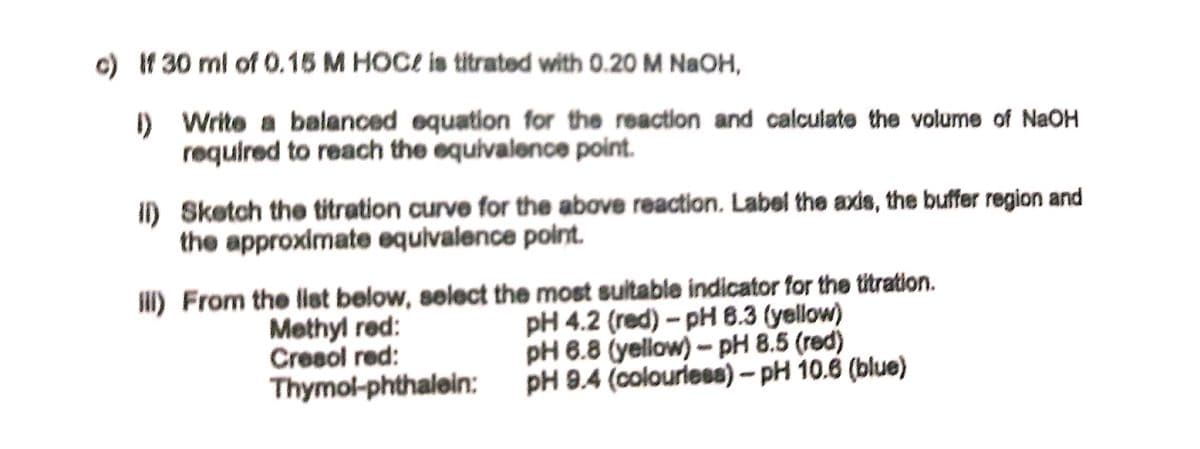If 30 ml of 0.15 M HOCE is titrated with 0.20 M NAOH, I) Write a balanced equation for the reaction and calculate the volume of NaOH required to reach the equivalence point. I) Sketch the titration curve for the above reaction. Label the axds, the buffer region and the approximate equivalence point. II) From the list below, solect the most suitable indicator for the titration. pH 4.2 (red)-pH 8.3 (yellow) pH 6.8 (yellow) - pH 8.5 (red) pH 9.4 (colouries) – pH 10.6 (blue) Methyl red: Cresol red: Thymol-phthalein:
If 30 ml of 0.15 M HOCE is titrated with 0.20 M NAOH, I) Write a balanced equation for the reaction and calculate the volume of NaOH required to reach the equivalence point. I) Sketch the titration curve for the above reaction. Label the axds, the buffer region and the approximate equivalence point. II) From the list below, solect the most suitable indicator for the titration. pH 4.2 (red)-pH 8.3 (yellow) pH 6.8 (yellow) - pH 8.5 (red) pH 9.4 (colouries) – pH 10.6 (blue) Methyl red: Cresol red: Thymol-phthalein:
Chemistry: Principles and Reactions
8th Edition
ISBN:9781305079373
Author:William L. Masterton, Cecile N. Hurley
Publisher:William L. Masterton, Cecile N. Hurley
Chapter14: Equilibria In Acid-base Solutions
Section: Chapter Questions
Problem 48QAP: A 0.2481 M solution of KOH is used to titrate 30.00 mL of 0.269 M hydrobromic acid. Assume that...
Related questions
Question

Transcribed Image Text:c) If 30 ml of 0.15 M HOCE is titrated with 0.20 M NaOH,
I) Write a balanced equation for the reaction and calculate the volume of NaOH
required to reach the equivalence point.
I) Sketch the titration curve for the above reaction. Label the axds, the buffer region and
the approximate equivalence point.
I) From the list below, select the most sultable indicator for the titration.
Methyl red:
Cresol red:
Thymol-phthalein:
pH 4.2 (red) - pH 8.3 (yellow)
pH 6.8 (yellow) - pH 8.5 (red)
pH 9.4 (colourieses) – pH 10.6 (blue)
Expert Solution
This question has been solved!
Explore an expertly crafted, step-by-step solution for a thorough understanding of key concepts.
Step by step
Solved in 2 steps with 2 images

Knowledge Booster
Learn more about
Need a deep-dive on the concept behind this application? Look no further. Learn more about this topic, chemistry and related others by exploring similar questions and additional content below.Recommended textbooks for you

Chemistry: Principles and Reactions
Chemistry
ISBN:
9781305079373
Author:
William L. Masterton, Cecile N. Hurley
Publisher:
Cengage Learning

General Chemistry - Standalone book (MindTap Cour…
Chemistry
ISBN:
9781305580343
Author:
Steven D. Gammon, Ebbing, Darrell Ebbing, Steven D., Darrell; Gammon, Darrell Ebbing; Steven D. Gammon, Darrell D.; Gammon, Ebbing; Steven D. Gammon; Darrell
Publisher:
Cengage Learning

Chemistry: Principles and Practice
Chemistry
ISBN:
9780534420123
Author:
Daniel L. Reger, Scott R. Goode, David W. Ball, Edward Mercer
Publisher:
Cengage Learning

Chemistry: Principles and Reactions
Chemistry
ISBN:
9781305079373
Author:
William L. Masterton, Cecile N. Hurley
Publisher:
Cengage Learning

General Chemistry - Standalone book (MindTap Cour…
Chemistry
ISBN:
9781305580343
Author:
Steven D. Gammon, Ebbing, Darrell Ebbing, Steven D., Darrell; Gammon, Darrell Ebbing; Steven D. Gammon, Darrell D.; Gammon, Ebbing; Steven D. Gammon; Darrell
Publisher:
Cengage Learning

Chemistry: Principles and Practice
Chemistry
ISBN:
9780534420123
Author:
Daniel L. Reger, Scott R. Goode, David W. Ball, Edward Mercer
Publisher:
Cengage Learning

Chemistry: The Molecular Science
Chemistry
ISBN:
9781285199047
Author:
John W. Moore, Conrad L. Stanitski
Publisher:
Cengage Learning

Chemistry & Chemical Reactivity
Chemistry
ISBN:
9781337399074
Author:
John C. Kotz, Paul M. Treichel, John Townsend, David Treichel
Publisher:
Cengage Learning

Chemistry & Chemical Reactivity
Chemistry
ISBN:
9781133949640
Author:
John C. Kotz, Paul M. Treichel, John Townsend, David Treichel
Publisher:
Cengage Learning